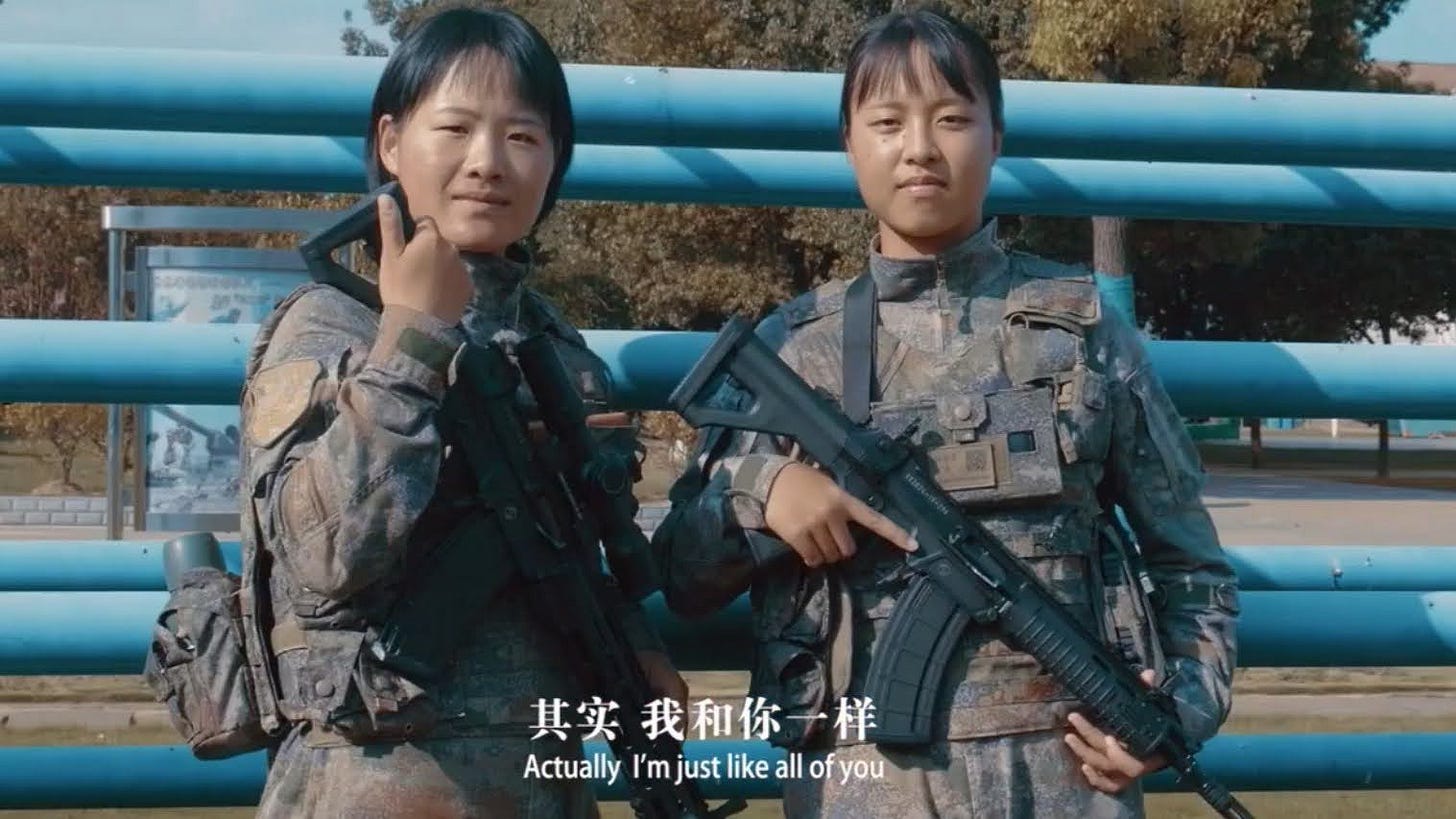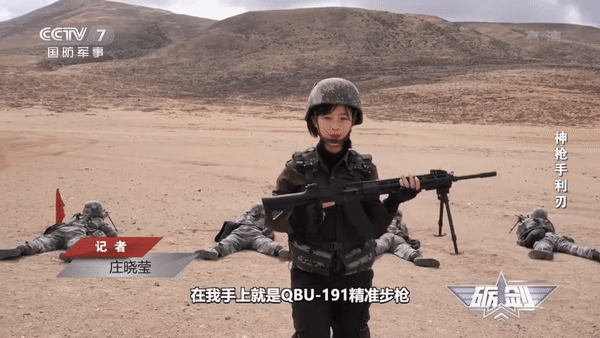What the PLA’s New Rifle Means for Taiwan + DC/NY Meetups
The Type 191 Rifle as a window into its future engagements
Jon of Asianometry is visiting, and we’ll be co-hosting a meetup in New York on February 15 at Pier 57.
I’m heading down to DC to hold a meetup on February 21st. Let me know if
Also…ChinaTalk is hiring analysts looking to cover China and AI! Consider applying here.
Now to Dylan Levi King for some gun talk.
The PLA are not given to providing martial or poetic names to their small arms. The rifle that these two young women are holding is called simply the Type 191. It’s the replacement for the Type 95, which replaced the Type 81, which replaced the Type 63 and Type 56.
The military began providing it to soldiers in 2019. It comes in a standard variant, as well as a shortened carbine version (that’s called the Type 192, or QBZ-192), and a precision marksman version (QBU-191, formally). Someday, these rifles will be carried by all branches of the People’s Liberation Army (PLA) and the People’s Armed Police (PAP).
Outside of specialty publications, the Type 191 has received minimal attention. Even those who cover developments in the Chinese military are more likely to devote their time to rockets and landing craft. For the generalist, the only military stories given serious attention in recent years are scandals, or perhaps, albeit with less interest, PLA Air Force incursions into airspace around Taiwan.
But the Type 191 can tell the future. It deserves our attention.
Tell me what rifle your army fields, and I will tell you what kind of battles they plan to fight. This is as true for the PLA as it is for any military.
To be sure, these predictions have some elements of uncertainty. It’s possible that a military has purchased the wrong rifle for its troops. Maybe military planners made an error, or corruption in the rifles’ acquisition gave the contract to the wrong shop — although such slip-ups are inevitably worked out once the bullets start flying.
The M16 is a good example. It was not the first rifle that the Americans took to Vietnam, but it was the one they chose when they decided that they had seen the future of warfare in Indochina. The M16 was not greeted by planners, frontline soldiers, or allied fighters with universal acclaim — but everything worked out: the rifle and its ammunition were light, so it was easy to lug through tough terrain, far from central resupply; and even though the smaller 5.56×45 mm cartridges packed less punch than the M14’s 7.62×51 mm, nobody was taking long shots in the forest, and minimal recoil improved accuracy for undertrained draftees.
In other words, the M16 was the ideal weapon for small-squad counterinsurgency. That's the kind of battle that the United States military would fight nonstop for the next half-century.
SIG Sauer’s space-age XM7 rifle — developed for the Next Generation Squad Weapon Program to replace the M4 (essentially a variant of the M16) — can likewise tell us a lot about where and how the United States military thinks it will be fighting in this century. The XM7, in contrast to the M16, is not meant for counterinsurgency. It’s not meant to lug through the jungle; it’s not a rifle to chase men with AKs down dusty streets. Chambered in 6.8×51mm, optimized for optics that integrate cutting-edge fire control, the XM7 is meant for highly trained special operations. It is a rifle for fighters who will be getting the drop from long-range, likely under the cover of darkness, on opponents wearing body armor. The XM7 is meant for facing off against near-peer forces.
The story of the Type 191 begins, as it turns out, in Vietnam, too.
Excepting some border scuffles and putting down armed Red Guard rebellions, the PLA’s February 1979 invasion of Vietnam was the first major fight it had been involved in since the end of the Korean War in 1953.
The PLA marched into Vietnam with obsolete weapons: most troops carried the semi-automatic Type 56 carbine, a Chinese variant of the Soviet SKS; only select members of some units carried the Type 56 automatic, the Chinese AK-47. People’s Army of Vietnam (PAVN) regulars had automatic AK-47s and the upgraded AKM variant. Meanwhile, some elite units, fresh from the campaign to topple the Khmer Rouge, carried the small-caliber, high-velocity AK-74 and captured American M16s.
Advances in the world of small arms passed China by. The Sino-Soviet split meant that China lost access to new AK variants. Research and development stalled, as even the basic work of upgrading Soviet rifles was hampered by political chaos and poor manufacturing capability. But this all might have had some predictive power, too — proof that they were not going to seek out conflict. Chinese rifles were more likely to be used by overseas proxies — like the Palestinian fedayeen, the Viet Cong, Sandinistas, Congolese rebels, and, later, Afghan mujahideen.
After the PLA crawled back across the border, Deng Xiaoping was made aware of the fiasco, and the Central Military Commission and planning departments of the PLA’s General Logistics Department were ordered to fix the problem with small arms.
The PLA realized that they needed a new kind of rifle for a new kind of war.
At first, designs were attempted that combined elements of the AK-47 and SKS, but these were put into service only in small numbers. They ended up being too expensive to produce, or they were too fragile, or they were chambered for small-caliber rounds that, due to limited manufacturing capacity, sometimes became unavailable. Most importantly, the Chinese leadership wanted a design that could not be mistaken for a Soviet knockoff.
Duo Yingxian 朵英贤, a middle-aged armorer who had trained under the Soviets, was put in charge of a small group of experts at China Ordnance Industries Group Corporation Limited (the domestic face of China North Industries Group Corporation Limited, or Norinco). They decided on 5.8×42mm as the standard round and built for it the Type 95 — a short, plastic rifle designed to put a lot of rounds on a target with high accuracy.
By the time the Type 95 approached completion, however, the border war with Vietnam was already over. The Type 95, then, was built for a time when China did not expect to find itself involved in any war; indeed, Norinco shipped more guns to sportsmen than guerrillas.
The Type 95 was not as durable as the SKS or the AK-47 variants. It wasn’t intended to be equipped with optics or other equipment. Its bullpup design made it shorter than an M16, AK-47, or AK-74, and the plastics incorporated in the design made it light — so perhaps it would have been the ideal rifle for jumping in and out of armored amphibious assault craft while taking an island, but it was never used for that purpose.
The Type 95 was intended to be pretty and sleek. It was not as rugged as what it replaced, and it was not as technologically advanced as its rivals. It was unsuited for being equipped with optics. Rather, it was a showcase for Reform and Opening manufacturing techniques. It was an advertisement for Norinco. It was the first Made in China rifle — for an era when China was at peace.
The Type 191 is intended to fix the problems of the Type 95. It is not intended merely to be handsome in the hands of parading troops, but to be used for the conflicts that the PLA expects are on the way.
What can the replacement of the Type 95 tell us about the battles that the PLA expects to fight — or not to fight?
The Type 191 came from the designers at No. 208 Research Institute of China Ordnance Industries — the direct successor of Duo Yingxian’s research group — and under the direction of Wang Guanghua 王光华, who was part of the Type 95 team. The No. 208 Research Unit tapped into a vast network of research and manufacturing units within Norinco to make a rifle that is the match of any fielded by advanced militaries. The 5.8×42mm cartridge size of the Type 95 is retained, but the ammunition has been upgraded for taking longer shots. The rifle’s internals are less interesting than its ability to carry cutting- edge equipment, like fire-control systems and second-generation night vision.
Unlike the Type 95, whose basic design was difficult to modify, the standard Type 191 is the basis for other rifles on the same platform. The shortened carbine version is ideal for the type of borderlands infiltration that the PLA and PAP take part in nowadays. The precision marksman version, optimized for longer shots, is an important supplementary weapon.
We continue with the Type 191’s implications for the likelihood of a Taiwan invasion scenario.





